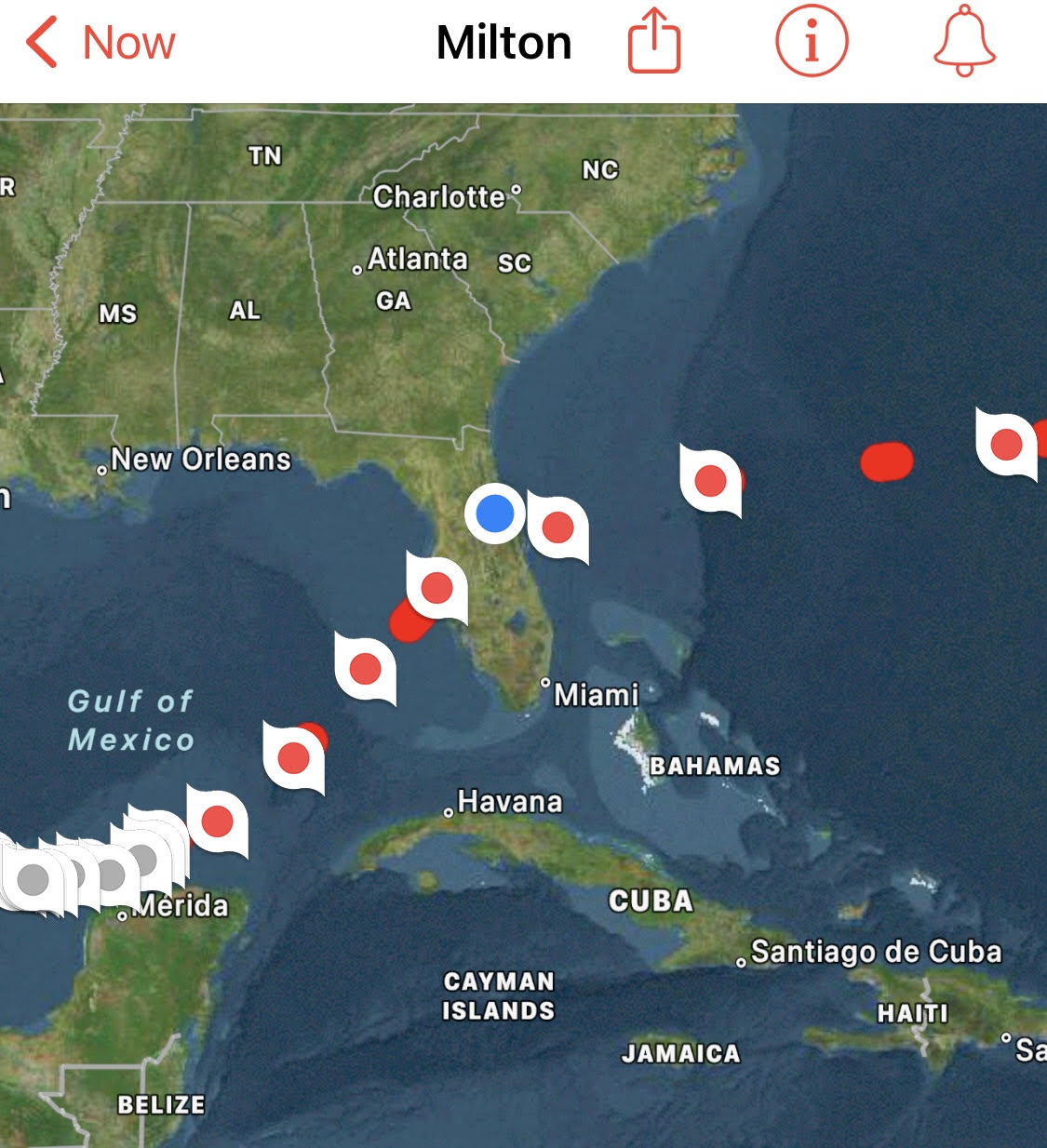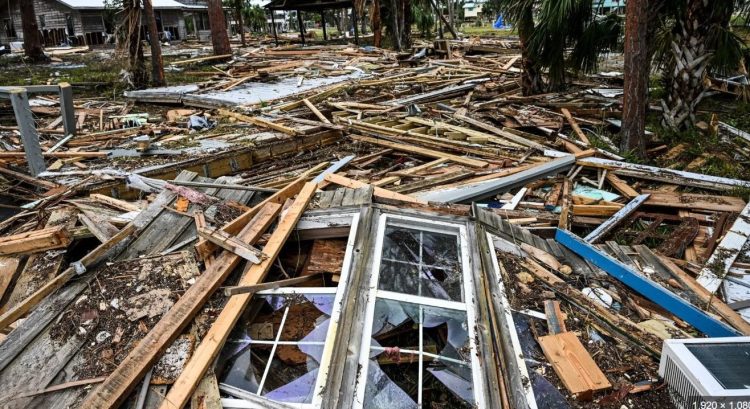I’ve never been a huge fan of hurricanes. One of my earliest memories is of losing my favorite aunt to drowning during Hurricane Agnes back in 1972.
As I write this, the sky is turning black, and it is only 11:00 in the morning. My home sits 14 miles from Daytona Beach and smack dab in the line of the storm. That’s it down there, the blue dot. The full force of Milton, now a Category 5 storm will be upon us in a few hours. Overnight, they always seem to be overnight.

Not to worry, though; I’ve been through this before. This is my family’s sixth major hurricane since we relocated to Florida a number of years ago. The key is preparedness and knowing how to survive afterward. The last time a storm this big passed through here our power was out for ten days and temps were in the 90’s in the house with about 90% humidity. No fun. It’s one thing to face danger during a deployment, but there is a different kind of tension when Mother Nature is the enemy. You can’t fight back, but you can prepare.
With that in mind, here is a straightforward guide to surviving a storm like the one that is heading my way.
Before the Storm Hits
Preparation is everything. You wouldn’t go on a mission without your gear in check, and the same applies here. First, secure your home. If you haven’t already installed hurricane shutters, make sure to board up your windows. Sheets of plywood work as well as anything else. Bring in anything outside that isn’t bolted down—furniture, grills, even those wind chimes your spouse likes so much. In winds over 150 mph, anything becomes a missile. Your job is to limit those potential projectiles.
Ok, bring in almost everything. You don’t want tanks of propane from your grill in your home or garage. I secure mine with a heavy chain to a 4″ by 4″ fence post embedded deeply in the ground.
And take pictures of your home, car and expensive belongings. Lots of pictures with lots of detail. In a worst case scenario, your insurance company will want to see these and they will be worth their weight in gold.
If you’re in an evacuation zone and you are told to leave, do it—plain and simple. Waiting it out is tempting, but this isn’t something to tough out like bad weather at sea. Know your evacuation route ahead of time and have a “go bag” packed with essentials: water, non-perishable food, medications, a first-aid kit, and important documents.
Some people, despite being given mandatory evacuation orders, decide to stay and brave what are called “unsurvivable” storms. In this case, my advice is grim: get a permanent marker and write the last four of your social security number and your last name on the inside of your forearm. It will make the job of the recover crews easier. Better advice: do the smart thing and get the hell out of Dodge while you can.

During the Storm
Once the storm starts, hunker down. Your best bet is to retreat to an interior room without windows. Bathrooms and closets work well. Don’t be fooled by the calm if the eye passes over you; things will ramp up again, fast. Keep a portable radio on hand to monitor updates, and if you lose power, keep your fridge closed as long as possible to preserve food. You may be tempted to go outside during lulls in the storm. Don’t do it. About 8 years ago one of my neighbors was killed doing this during a relatively mild hurricane (if there is such a thing). She was taking her dogs out in their yard, and a large branch fell from an oak tree and broke her neck.
Exit your safe space with extreme caution and only when you know the storm is completely over.
If you’re using a generator, be cautious. Carbon monoxide is a silent killer. Never run it indoors or too close to windows and doors. And yes, I feel kind of silly for having to tell you this, but your attached garage is still considered to be inside. After every storm, there are stories of those who succumb to carbon monoxide poisoning because they ran generators in their garage. Don’t do it!
It’s no different than knowing where the muzzle of your weapon is pointing—always be aware of the dangers.
After the Storm
Once the authorities give the all-clear (you have your weather radio to get this information from, right?), it’s time to assess the damage. Stay clear of downed power lines and avoid any floodwaters. They could be contaminated with chemicals or, worse, downed electrical lines. As you assess the damage, document everything. Take pictures and keep receipts for temporary repairs—insurance companies are meticulous.
This is where your pre-planning pays off. You are going to need water, a rule of thumb is to have a gallon a day for each person in the household. I recommend a seven-day supply. In addition to bottled water, you can purchase plastic cubes that hold about 5 gallons each. They have a spigot on them and come in quite handy after storms. Don’t open the doors of your freezer or refrigerator any more than you have to. In hot climates, your food will spoil quite quickly, so have canned or packaged food on hand. A seven day supply is a good start. It’s better to have it and not need it than to need it and not have it. And don’t forget about your pets. Make sure they have enough food and water as well. If you take medications, make sure you have at least a week’s supply of those. Two weeks is better. Have a Lifestraw in your hurricane kit; it can literally save your life. Its micropore filters can make unpotable water potable. Be sure to read the instructions before you use it, it doesn’t turn raw sewage into Perrier.
If you live in a hot climate, make sure to have some cooling pads on hand. Soak them with water and put them around your neck or over your head if you get overheated. Evaporative cooling can make you feel much more comfortable in these situations.
Have cash on hand because with the internet down there is no way to pay for anything electronically. Your plastic is useless.
If you are left without power, be patient; it’s not the end of the world. Proper planning will make the experience as bearable as possible.
Stay safe, and see you on the other side of the storm.
—
Disclaimer: SOFREP utilizes AI for image generation and article research. Occasionally, it’s like handing a chimpanzee the keys to your liquor cabinet. It’s not always perfect and if a mistake is made, we own up to it full stop. In a world where information comes at us in tidal waves, it is an important tool that helps us sift through the brass for live rounds.









